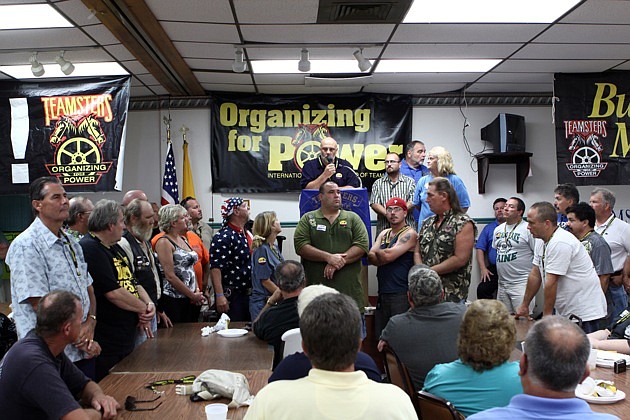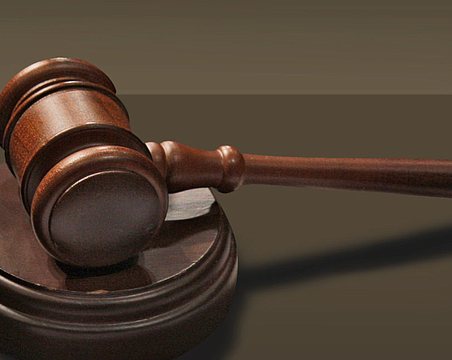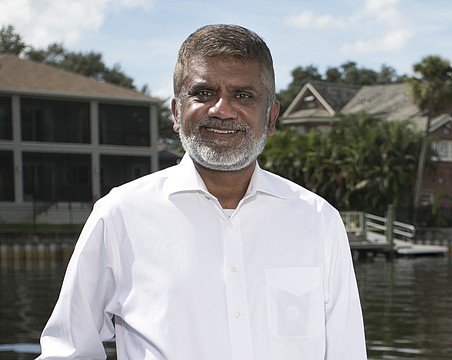
Most of us associate union power with big northern cities and Teamsters and UAW workers. But Florida — and specifically, local Florida governments — is square in the crosshairs of the nation's major unions.
“Florida is one of the fastest growing in organizing. We've been pretty active in public employees,” says Ken Wood, president and business manager Teamsters Local 79 in Tampa.
His local, covering the Gulf Coast, has gone from 25% public employees three years ago to 40% now. And he is aiming for a lot more.
It's easy to see why. Nationally, the trend in union membership growth has been toward government employees and away from old-line blue-collar workers.
With the economy wobbly and the Gulf Coast of Florida still reeling under double-digit unemployment, government budget cuts and layoffs are making local government workers prime targets for unionizing. In the past three years, unions have won 72% of unionizing elections in Florida.
International Brotherhood of Teamsters' General President Jim Hoffa led a union rally of 500 Pasco County government workers Aug. 22. About 1,100 county employees will vote Sept. 7 on whether to unionize with the Teamsters.
A few days after the rally, Hoffa boasted of the union's inroads in Florida counties in a speech at the Teamsters National Black Caucus conference, and guaranteed victory in Pasco County.
In recent years, the Teamsters have added to its 1.4 million members by organizing county government agencies in Collier, Hernando, and Citrus. The union now includes 239,000 public sector employees nationally.
And this activity is in addition to perhaps the single strongest political player in Florida: teachers unions.
In Sarasota County, the teachers union almost single-handedly passed a one-mill tax extension by generously funding the pro-tax PAC and getting its 5,000 members to the polls in a light-turnout spring election.
No union in the state can touch the Florida Education Association in numbers and as a force to be reckoned with politically.
The FEA boasts 140,000 members and has been reinvigorated by Gov. Charlie Crist's veto of Senate Bill 6. After the Legislature passed the measure tying student performance to teacher compensation, the FEA's members sent thousands of emails to Tallahassee in an all-out lobbying campaign leading to Crist's veto.
Now, Crist's U.S. Senate campaign likely hinges on teachers' and union support to take enough votes away from Democratic nominee Kendrick Meek to defeat Republican Marco Rubio. Crist has nabbed several union endorsements as part of his run as an Independent.
All of this unionizing can protect workers' jobs, but it also tends to add to the cost of government and diminish efficiencies.
Battle along the coast
According to Lee County Public Safety Director John Wilson, union organizers are now prowling his county's offices and workshops. Although there may be little he or his boss can do to stop it, they are prepared to try.
Karen Hawes, Lee County's Administrator, the county's former head of the human services department and a budget analyst before that, says she thinks she can convince county employees that they'll be better off without unionizing, but the odds are stacked against her.
As for the two existing unions' contracts, Hawes says, “We're going back to the table with our unions. We're going to talk some turkey and see if we can get them down.”
Following a successful election to organize in August, Lee County entered into negotiations with the International Association of EMT's and Paramedics (a division of the National Association of Government Employees) and the Southwest Florida Professional Firefighters and Paramedics Local 1826.
She's motivated to control costs; the county has a $70 million structural deficit and has been depleting reserves — roughly $65 million taken from reserves last year — to balance the budget.
Hawes is in plenty of company among other local governments up and down the Gulf Coast. Cities and counties can't expect much more financial help from the state or the feds. There will be more cutbacks, the question is where.
The lack of funds and union demands for an even larger share of the shrinking pie sets up a war between unions and government agencies to be played out across the region, state and nation.
$1 trillion pensions tab
Nationally, 90% of state and local government workers have access to employer-provided retirement benefits, while only 65% of private-sector employees do. According to the U.S. Bureau of Labor Statistics, 83% of government employees make more money than private-sector workers in comparable jobs.
It's no wonder that as of the end of fiscal year 2008, state and local taxpayers are stuck with a $1 trillion gap to cover government employee retirement benefits. According to the Pew Center on the States, these governments have $2.35 trillion to pay for pensions, health care and other retirement benefits, but there's a $3.35 trillion debt.
Florida faces a $6 billion budget deficit next year, its part of the projected total combined gap in U.S. state budgets of $180 billion for the 2011 fiscal year that began July 1. That figure comes from the liberal Center on Budget and Policy Priorities.
On the Gulf Coast, the cities of Cape Coral and Sarasota and the Town of Longboat Key have wrestled with unfunded pension fund liabilities.
Pinellas County is working to close a $40 million budget gap and is also looking to renegotiate union contracts; firefighters being one key target according to Commissioner Ken Welch, a Democrat, suggesting there may be some hope of controlling government labor costs.
All of this creates fertile ground for public sector unionizing.
Public unions' growth trend
In 2009, Florida had 489,000 public employees in collective bargaining units, according to the U.S. Bureau of Labor Statistics. And union organizers aim to build on that number.
The shift to unionizing more public workers has accelerated with the state's high unemployment, particularly among construction employees who were union members.
From 1973 to 2009, unionization rose in the public sector from 24.1% to 37.4%, according to the U.S. Department of Labor, while unionization in the private sector fell from 25.4% to 7.2%. Click here for a more detailed look.
Labor union data for the Gulf Coast's five metropolitan statistical areas show that public sector union membership has increased 1% from 2006 to 2009 even as unemployment shot up past 11%. In comparison, private sector unions' ranks fell 25% during the same timeframe just when construction came to a halt across much of the region. (See table.)
Overall, in Florida, the number of dues-paying union members fell from 482,000 in 2008 to 411,000 in 2009, a reflection of the increase in unemployment, which exceeds a million.
Those 411,000 represent just 5.8% of the state's then 7.9 million workers, much lower than the 12.3% national average, but also representing opportunity for union organizers. The number of employees represented by a union fell from 601,000 to 489,000.
Nationally, according to the U.S. Bureau of Labor Statistics, the membership in public sector unions now exceeds that of private sector unions — 7.9 million versus 7.4 million — despite there being more than five times as many wage and salary workers in the private sector.
In 2009, 12.3% of wage and salary workers belonged to unions in the U.S. But within the public sector, local governments had the highest union membership rate at 43.3% last year.
This group includes the typically heavily unionized jobs such as teachers, police officers, and firefighters. In the private sector, high unionization is found in industries including transportation and utilities, telecommunications, and construction.
Batting .720
In the last 36 months, 153 union organizing elections took place across Florida with unions winning 72% of the time, according to the state's Public Employees Relations Commission.
That's a pretty good batting average that is likely to encourage union leaders to continue to step up to the plate. Here is some of the government union activity going on right now:
• The Suncoast Police Benevolent Association has an election coming up to organize employees of the Pinellas County Sheriff;
• In June, Pinellas Lodge 43 of the Fraternal Order of Police won certification to represent city of Gulfport police;
• Another union force to be reckoned with is the International Union of Police Associations, affiliated with the AFL-CIO, which set up its headquarters in Sarasota last year. It has an election pending with city of Port St. Lucie employees;
• Another dozen elections are pending, including the Teamsters in Pasco and the Suncoast Police Benevolent Association competing with the Fraternal Order of Police for the Pinellas County Sheriff union contract.
And when union organizers aren't working city halls or state college campuses their phones are ringing. “I am getting calls from a number of places where they would like to form a union,” says Michael Temple, director of Region 3 for AFSCME Council 79, the state's chapter.
Region 3 includes the Tampa Bay area and down to Naples. AFSCME 79 is the second largest union in Florida and represents 110,000 employees of the state, state universities, cities and counties, school boards and private nonprofit hospitals.
In Region 3, the union represents roughly 1,100 employees at the University of South Florida, nearly 90 at New College in Sarasota, plus employees of Hillsborough County, Manatee County schools' support personnel, the cities of Pinellas Park, Bradenton, North Port, Venice and Sanibel.
Two Teamsters locals operate in the Gulf Coast: Local 79 in Tampa, headed by Wood; and Local 173 based in Bradenton, headed by Robert Tuttle.
Wood is also vice president of the International Brotherhood of Teamsters Southern Region and will be following the vote in Pasco County closely.
He says that the public sector is still “virgin territory.”
Three years ago Local 79 represented about 75% private employees and 25% public sector workers. Now, having gotten Collier County several years ago, and Hernando County in 2008, Wood says they're up to 40% public employees.
The Florida Public Services Union, an affiliate of Service Employees International Union, represents 19,000 workers in eight counties, 16 cities, three Head Start agencies and four school districts in the state. Its western area includes the city of St. Petersburg, Hillsborough Community College, Pinellas County Schools and the Pinellas Suncoast Transit Authority.
FLORIDA IS A 'RIGHT-TO-WORK' STATE
As one of 22 right-to-work states, Florida laws protect private-sector employees from being fired for not paying union dues. Florida is one of five states where an employee's right-to-work is established under the state Constitution, not just by statute. The federal Taft-Hartley Act also bars union dues payments as a requirement in state and local government employment. Public employees are prohibited from striking under the Florida Constitution and state law, but they can organize and negotiate collective bargaining contracts.
UNION ROLL CALL
Some of the public employee unions representing government workers on the Gulf Coast:
AFSCME Council 79 Region 3
University of South Florida
Hillsborough County
City of Pinellas Park
Manatee County Schools Support Personnel
City of Bradenton
City of Venice
City of North Port
City of Sanibel
City of Naples
New College
Florida Gulf Coast University
Teamsters Local 79
Hillsborough County Aviation Authority
Hartline
Collier County School Board
Teamsters Local 173
City of Sarasota
Sarasota County
Service Employees International Union-Florida Public Services Union
City of St. Petersburg
Pinellas County Schools
Pinellas Suncoast Transit Authority
Hillsborough Community College
International Brotherhood of Firemen and Oilers, Local 1220
City of Temple Terrace
City of St. Petersburg
United Faculty of Florida-Faculty United Services Association
Hillsborough Community College
Edison College
Florida Gulf Coast University
New College of Florida
University of South Florida
Teachers and School Support Personnel Unions
United School Employees of Pasco, Local 3600
Hillsborough County Classified Teachers Association
Pinellas Classroom Teachers Association
Pinellas Education Support Personnel Association
Manatee Education Association
Sarasota Classified/Teachers Association
Charlotte County Education Association
Island Coast FEA Service Unit
The Teachers Association of Lee County
Support Personnel Association of Lee County
The Collier County Education Association
Note: Sheriff and police employees are represented by units of unions including the Police Benevolent Association (PBA) and the International Union of Police Associations (IUPA). Firefighters are generally represented by units of the International Association of FireFighters (IAFF). They are not listed as each municipality tends to have its own.







